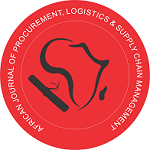Tetteh Moses Kofi
Department of Procurement & Supply Chain Management,
Accra Technical University
Email: tettehmoseskofi@gmail.com
Abstract
The purpose of this research is to identify the impact of procurement consolidation in humanitarian supply chain (a case study of national disaster management organization NADMO), with some problem statement which include, Lack of coordination in the activities of various governmental and non-governmental agencies in the management of disasters. The research method used for this study include experimental research, questionnaires, etc. the researcher administered twenty (20) questionnaires to specific departments within the organization where information where gathered for a successful completion of these project. This study consisted of three main objectives as follows. To determine the extent of Supply Chain Management consolidation within humanitarian organizations in national disaster management organization NADMO, to determine the relationship between Supply Chain Management Integration and the performance of humanitarian organizations in national disaster management organization NADMO, to determine the challenges of Supply Chain Management Integration in humanitarian organizations in NADMO. Amidst several recommendations, the researcher finally recommended that, SCM integration has enabled international humanitarian organizations achieve better performance. Other organizations should also be encouraged to adopt the same in order to provide faster and efficient goods, works and services to the beneficiary. Also, post-disaster procurement is necessary because disasters are unpredictable in nature (Balcik et al. 2010). The location, timing and severity of a disaster are unknown, hence the relief organization prefers making procurement decisions after a disaster occurs.
Problem Statement: Procurement consolidation in humanitarian supply chain can be done in before or after disaster. Procurement at pre-disaster is necessary for prepositioning relief supplies in strategic locations near disaster prone areas. The beneficiaries are supplied from pre-positioned inventory during the initial days after the disaster. Therefore, having those supplies ready to dispatch is of critical importance. Nevertheless, only a small percentage of the total relief supply is sourced from the pre-positioned inventory (Balcik and Beamon, 2008). When a disaster occurs, a relief organization is interested in procuring a relief item in large amounts and it is not economical to pre-position large amounts of inventory for this item. Thus pre-positioned inventories are usually insufficient in many disaster relief operations. Also, post-disaster procurement is necessary because disasters are unpredictable in nature (Balcik et al. 2010). The location, timing and severity of a disaster are unknown, hence the relief organization prefers making procurement decisions after a disaster occurs. In this study, a multi-attribute reverse auction mechanism is addressed to purchase required relief items at the post-disaster. It is worth noting that in addition to using prepositioned inventories and post-disaster procurement auctions, part of relief items’ demands can be satisfied via special supply contracts set by some suppliers at pre-disaster and in-kind donations. In the supply contracts, large humanitarian organizations establish long-term agreements with suppliers to supply certain amount of relief goods on demand. Also, the amounts of in-kind donations as another supply source are unpredictable and tend to proliferate after the disaster strikes and needs to be sorted, prioritized, and stored. Since, the suppliers might become unavailable after the disaster occurs, the utilization of all available resources is necessary; hence, we consider these different supply sources in our proposed model. At below, we give more explanation for the main features, assumptions and formulation of our proposed model.
Keywords: Procurement Consolidation, Humanitarian Supply Chain, Disaster Management

